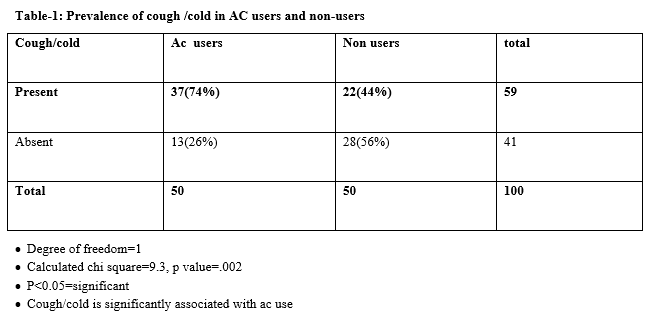Prevalence of respiratory illness among A.C users at Indore city: A case control analytical study
Abstract
Background-In hot, humid climates air conditioners are not only a modern comfort but an essential element in getting through those sweltering, sticky days. But, like most modern conveniences, air conditioning also has its down-sides.
Objectives- 1.To know association between air conditioner users and respiratory illness 2.To know prevalence of respiratory illness in Air-conditioner users in comparison to non user.
Material and methods-It’s a Case-control study(Analytical study) case-Randomly selected 50 person of age group 25-50 yrs working in IDBI Bank, using AC were selected as case while Randomly selected 50 person of same age group working in NVDA Office who did not use AC at all served as controls. After Filling of Questionnaire & Compilation of data and was analysied using MS Excel and SPSS.
Result- 57% of A.C. user were using A.C. for <3yrs and 44% of them using for >3yrs. Most (66%) of the people using ac at office time and 7% of them using continuously. 83% of A.C. users are not aware about necessity of cleaning of ac filters. cough/cold is significantly associated with ac use. (Calculated chi square=5.54, P<0.05=significant)
conclusion- cough/cold, Running nose & Headache were significantly associated with Ac users. Findings were suggested that AC users were more prone to mild respiratory illness while association between Skin irritation and Ac use is not significant.
Downloads
References
2. Malcolm J.J.History of air conditioning. Newsweek Winter 1997; 130(24):42-4.
3. Yaglou CP. Hospital air conditioning. J Am Med Assoc. 1938; 110(24):2003-9. doi:10.1001/jama.1938.62790240003010 available at nyamcenterforhistory.org/2015/.../how-air-conditioning-changed-the-nic
4. Menzies D, Popa J, Hanley JA, Rand T, Milton DK. Effect of ultraviolet germicidal lights installed in office ventilation systems on workers' health and wellbeing: double-blind multiple crossover trial. Lancet. 2003 Nov 29;362(9398):1785-91.
5. Takano J. Does Your Air-conditioned Room Make You Sick? Available at http://www.pyroenergen.com/articles/airconditioner.htm
6. Caire N, Cartier A, Ghezzo H, Malo JL. Influence of the duration of inhalation of cold dry air on the resulting bronchoconstriction in asthmatic subjects. Eur Respir J. 1989 Sep;2(8):741-5.
7. Parsons, K. Human Thermal Environments, 2nd ed.;Taylor and Francis: New York, NY, USA, 2003, available at www.jourlib.org/references/9335286.
8. Brady WJ Jr, Stremski E, Eljaiek L, Aufderheide TP. Freon inhalational abuse presenting with ventricular fibrillation. Am J Emerg Med. 1994 Sep;12(5):533-6.
9. Yuan-Ching Hseih, Regina Frayser, and Joseph C.Ross. The effect of cold air inhalation on respiratory gas exchange during exercise in patients with chronicobstructive pulmonary disease. Chest 1970;57;18-21, available at journal.publications.chestnet.org/article.aspx?articleid=105800
10. Preziosi P, Czernichow S, Gehanno P, Hercberg S. Workplace air-conditioning and health services attendance among French middle-aged women: a prospective cohort study. Int J Epidemiol. 2004 Oct;33(5):1120-3. Epub 2004 Aug 19.
11. Hendrick DJ. Contaminated humidifiers and the lung editorial, available at http://www.ncbi.nlm.nih.gov/pmc/articles/PMC460040/pdf/thorax00232-0004.pdf
12. Khaliq F, Sharma S, Tandon OP. Pulmonary functions in air conditioner users. Indian J Physiol Pharmacol. 2006 Jan-Mar;50(1):67-72.
13. Borse LJ, Yadav RD. Pulmonary Function Tests in Young Healthy Male Exposed To Air Conditioned Work Environment. International Journal of Health Sciences & Research 2012 Sept 35- 6. available at www.ijhsr.org/archives_vol_2_Issue6_2012.htm
14. George SO. A Study Of Peak Expiretory Flow Rate In Air-Condition Users, International Journal of Basic and Applied Physiology 2012, Vol 1(1) 154 avaailable at ijbap.weebly.com/uploads/1/3/1/4/.../30_final_ijbap_version_1.5-.pdf
15. Babitha R et al. Pulmonary Function Tests in Air Conditioner Users, Journal of Clinical and Diagnostic Research. 2011 June, Vol-5(3): 532-5 available at www.jcdr.net/articles/PDF/1396/1909~final.pdf
16. Choudhari SP, Doiphode RS. Study of Pulmonary Functions in Air Conditioned Car Drivers: A Cross-sectional Study. Journal of Dental and Medical Sciences 2014 Dec (13) 48-50 available at iosrjournals.org/iosr-jdms/papers/Vol13.../Version-6/K0131264850.pdf
17. Jeelani M, Ahmed MM. Effect of Air Conditioner on Pulmonary Functions in Healthy Males in and Around Raichur City. Journal of Evidence based Medicine and Healthcare. 2015 Vol 2 (19) 2816-21 available at www.jebmh.com/latest-articles.php?at_id=1019
18. Mendell MJ. Commentary: air conditioning as a risk for increased use of health services. Int J Epidemiol. 2004 Oct;33(5):1123-6. Epub 2004 Aug 19.

Copyright (c) 2016 Author (s). Published by Siddharth Health Research and Social Welfare Society

This work is licensed under a Creative Commons Attribution 4.0 International License.


 OAI - Open Archives Initiative
OAI - Open Archives Initiative


